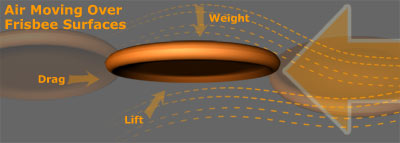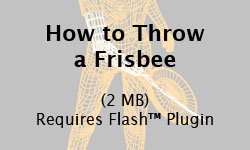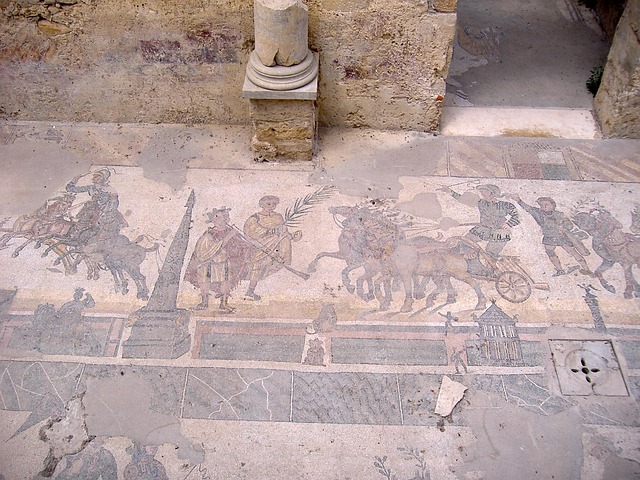The Frisbee, generally held to be a simple toy for children, was invented and refined in the late nineteenth century. Although it has grown in popularity since then, its general design, and thus the technique for its use, have remained fairly constant. The flight of a Frisbee is allowed and governed by the principles of physics. It is only through the combination of forces, rotational motion, and precession that it is allowed to fly along a straight trajectory.
Introduction
Most of us have enjoyed a game of Frisbee while at the beach or in the park. However, not many of us know much about how this toy was invented or how it works.
The story of the Frisbee’s origin is interesting: it seems difficult to imagine that the first Frisbees were actually tins used to hold pies. When these pie tins were redesigned into the plastic disc that we are familiar with today, the Frisbee became one of the most identifiable and popular toys of the past century.
Externally, the Frisbee is simple. It is merely a disc with a concave and convex side. It is fairly simple to throw. It is necessary, however, to understand these basics in order to understand the more complex physics that govern the flight of the toy.
The forces that act on a Frisbee and the Frisbee’s rotational motion are what account for its stable linear trajectory in the air. The effects of the forces and the rotational motion permit a Frisbee to fly in the air instead of plummeting to the ground.
The History of the Frisbee
The word “Frisbee” was derived from the name of William Russell Frisbie. In 1871, Frisbie bought a bakery in Bridgeport, Connecticut, and named it the Frisbie Pie Company. Located near Yale University, the Frisbie Pie Company sold pies to students at the college. After eating the pies, the students discovered that the pie tins flew when thrown in the air. Students played with these pie tins by throwing and catching them, thereby initiating the first games of Frisbee. As the tins had the words “Frisbie Pie Company” imprinted on them, the name Frisbie was permanently associated with the toy and the activity [1].
It was not until 1948 that Fred Morrison, a part-time inventor, became aware of this novel college pastime. He designed a plastic version of the metal tin that could fly longer distances and be thrown with better precision. He began selling his flying plastic discs at county fairs, where audiences were fascinated by them [1].
In 1955, Morrison sold the patent on his invention to a California-based toy company called Wham-O. Within two years, Wham-O began large-scale production of the discs. They renamed the toy as the “Frisbee” for marketing purposes and obtained a registered trademark for it. The Frisbee was a success for Wham-O, as it sold over 100,000,000 units.
Mattel Toy Manufacturers owns the trademark for the Frisbee today, having bought it from Wham-O. In addition, there currently exist 60 other manufacturing companies that market their own versions of the Frisbee [2].
The Design of a Frisbee
Current Frisbee design is more or less consistent with the design of the first Frisbees manufactured by Wham-O. According to their patent filed in 1965, “the toy comprises of a central portion and a rim circumscribing the central portion and curving downwardly from the central portion. The central portion and the rim together form a concave and convex side of the toy, wherein the rim has a greater thickness than the central portion.” The curved part of the convex side has “plurality of ridges,”or corrugations, “superimposed or raised on it” in concentric arrangement” (Fig. 1) [3].
The Physics of Frisbee Flight
After a Frisbee is thrown, there are different forces that act on the disc. Additionally, the Frisbee has spin applied to it that makes it rotate. The combination of the forces acting on the Frisbee and the rotation explain how it is able to follow its particular path.
When a Frisbee is thrown, there are essentially three forces that act on it: weight, lift, and drag (Fig. 2). Weight is the gravitational force that the Earth exerts on the Frisbee. For a Frisbee to sustain its vertical position in the air for a significant amount of time, a force must be present that counteracts the weight. This force is called the lift.
One of the properties of air is that if an object is moving through the air, the air exerts a net force on the object. This net force can be thought of as two components, lift and drag. Lift is the force that acts in a perpendicular direction to the flow of the air, and drag is the force that acts parallel to the flow of the air [4].
As a Frisbee moves, the air over the top face will eventually travel faster than the air under the bottom face. This occurs because the Frisbee has its convex side facing upward and concave side facing downward, and because the disc makes a small angle with the ground. The difference in the speed of air traveling over the surfaces, in turn, creates a difference in pressure acting on either surface. The pressure on the bottom face of the Frisbee is greater than the pressure on the top face. This imbalance in pressure results in a net force that acts on the Frisbee, the two components of which are called lift and drag [5].
The lift is what counteracts the weight of the Frisbee, which tries to make the Frisbee fall towards the ground. The lift opposes this downward motion by pushing the Frisbee upwards, thereby sustaining its vertical position.
Drag, which results from air resistance, inhibits the forward motion of the Frisbee. Ideally, the Frisbee should have a minimum amount of drag force for it to have the greatest range. The drag force is related to the Frisbee’s angle with the ground. When the Frisbee makes a small angle with the ground, the drag force acting on it is minimized, thus helping it travel longer distances [6].
Rotation of a Frisbee
Adding spin to a Frisbee while throwing it is crucial in providing it with stability in the air. As just stated, when air flows over the surfaces of the Frisbee, lift is generated and acts vertically upwards. The lift force, however, is not perfectly centered at the middle of the Frisbee. The lift force actually acts on the front part of the Frisbee. Because of this, the Frisbee experiences a torque that tends to flip the Frisbee over about its center. Therefore, a Frisbee that does not have any spin will flip about its center and quickly fall to the ground [5].
However, if spin is applied to Frisbee, a gyroscopic phenomenon known as precession takes place. Precession also accounts for why bicycle wheels and tops are able to stay upright while spinning, but topple over when not. As the spinning Frisbee flies through the air, the non-centered lift force creates a torque that tries to flip it over in the direction shown. However, as the Frisbee rotates to its new position, the lift force now acts at a new point on the Frisbee, and the torque tries to flip over the Frisbee in a new direction. As the Frisbee rotates through 360 degrees, the torques acting at all the different points negate each other, and the Frisbee is able to stay upright without flipping over [7].
Additionally, while a Frisbee spins, “the ridges on the Frisbee’s top surface introduce microscopic turbulence into the layer of air” above it, and this turbulence “helps keep the upper airstream attached to the Frisbee, thereby allowing it to travel farther.”[5]. Therefore, the ridges on a rotating Frisbee cause the lift force to act on the Frisbee for a longer time, thus extending its range.
Conclusion
The Frisbee started off as nothing more than a container that carried pies for the Frisbie Pie Company. However, through the ingenuity of some college students, the inventiveness of Fred Morrison, and the marketing savvy of the Wham-O Manufacturing Company, it eventually became an immensely popular and internationally recognized toy.
By analyzing the design of this invention, one observes that the Frisbee has a convex upper side, a concave lower side and ridges along the curved surfaces. In the technique of throwing the Frisbee, it is important for it to have an angle of attack and to apply spin in order for the throw to be successful.
By looking at the forces acting on the Frisbee and how they are generated, we can understand their role in determining the Frisbee’s flying path. Finally, the rotation of a Frisbee, by means of precession, allows it to stay upright in the air.
Tossing the Frisbee around amongst friends in the park, at the beach or even in the backyard is indeed a fun-filled experience. It is remarkable to think that this enjoyment would not be experienced if it weren’t for the complex physical principles at work on this simple toy.






